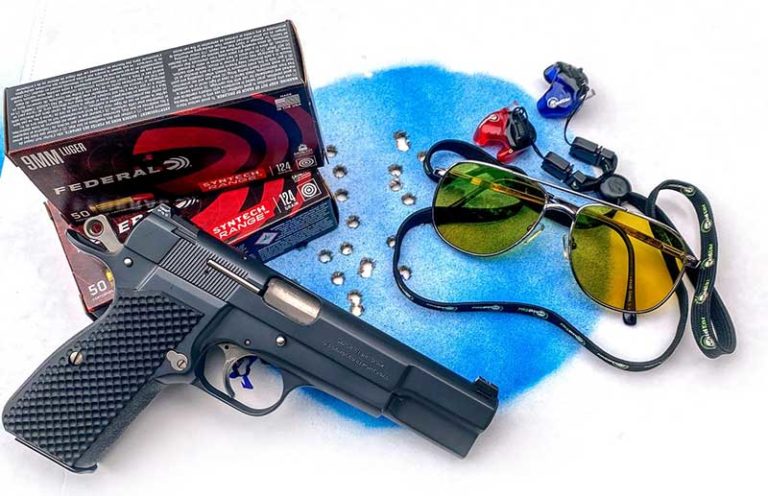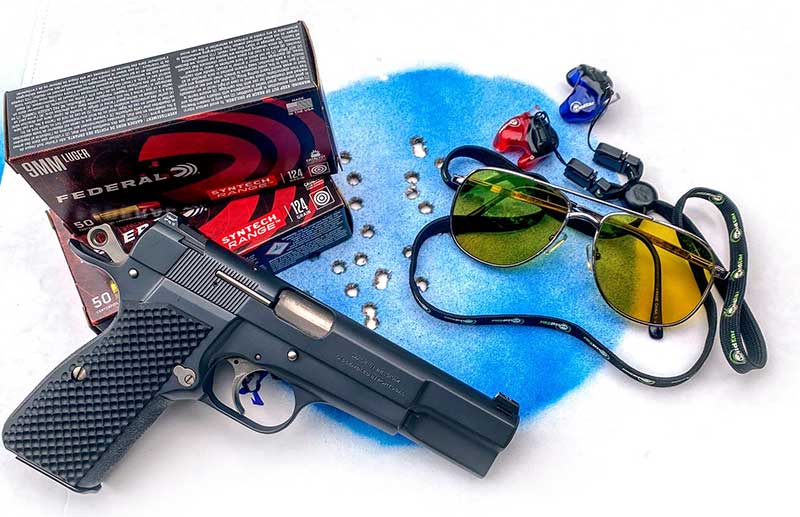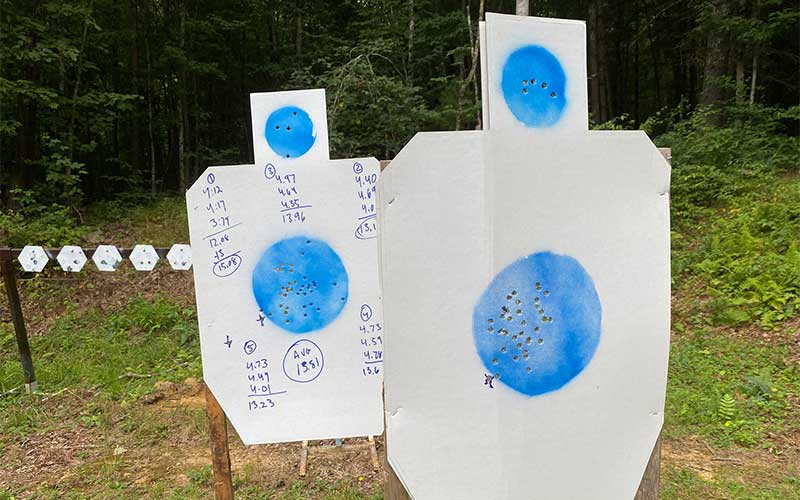
A defensive handgun drill for testing your practical defensive shooting skills with a concealed carry pistol.
There are all sorts of shooting drills you can conduct for practice, training or to evaluate your proficiency. Some drills isolate individual skills, such as shooting with your strong hand, conducting a reload, engaging multiple targets or maybe clearing stoppages. Others combine a collection of different skills to provide a more comprehensive estimation of your abilities. The drills you conduct and give credence to should be based on what you desire to accomplish, measure or test.
Establishing Your Standard
If you’re a competitive handgun shooter who likes to participate in IDPA or IPSC matches, you might focus on specific skillsets. If you just want to improve your base-line proficiency with a defensive handgun, you might work with different drills highlighting those things. There’s really no wrong or right drill if it has a practical relation to real-world application. You’ll have to decide that on your own, and you’ll also have to decide how to score, evaluate or critique the drills you conduct. And, you’ll have to decide whether your goal is to compete against yourself, some predetermined par or other shooters.

Typically, scoring is conducted through a combination of hits and time. Time restrictions impose a level of anxiety and, of course, hitting is the purpose of shooting. You can assign a point value for each hit and divide the total points by the time it took you to compete the drill. This is the Comstock method and is commonly used in IPSC matches.
Another method is the “Vickers Count,” which is used in IDPA matches. With this method, you take your elapsed time and add 1 or more seconds for misses, hits in various scoring zones or penalties. There’s really no wrong or right way to score a drill as long as it prevents gamesmanship. You don’t want to be able to game the drill in some manner that allows for a good score without following the spirit of the exercise.
Bill Wilson, founder of Wilson Combat, sent me a drill recently that he calls the “CCW Basic Proficiency Test.” He described the drill as being a basic test to see if you’re actually proficient enough to be carrying a concealed handgun. After looking at the content of the drill and conducting it five times, I think Bill might be on to something.
No, I’m not suggesting this drill/test should be mandated by government agencies issuing concealed-carry permits; I consider concealed carry a basic fundamental right. But I do think those who carry concealed should establish a certain level of proficiency for themselves, just as they might before operating a chainsaw. This drill/test is a reasonable way to measure that.
The Proficiency Test
To conduct Wilson’s CCW Basic Proficiency Test, you’ll need two standard IDPA or similar targets. (I didn’t have any IDPA targets, so I took two IPSC targets and painted an 8-inch circle in the chest area and a 4-inch circle in the head area.) Place the targets side by side, 6 feet apart. You’ll also need a shot timer, 18 rounds of ammunition, your carry gun in its commonly used concealable holster, and some sort of garment that actually conceals the pistol.
The idea is to shoot this drill cold, meaning no warm-up. And, this is a test, not a practice regime.
Starting with your handgun in your holster, standing 5 yards from the target, draw and engage Target 1 with two shots to the body and one shot to the head, then transition to Target 2 and do the same, for a total of six shots. Write down your time. (Just write your time on the target with a marker. This makes it easy to keep track of and reference later.)

For the next string of fire, remain at 5 yards and, after drawing from the holster, fire three shots at the body of Target 1 and three shots at the body of Target 2 using your strong hand only, for a total of six shots fired. Again, write down your time.
For the final string of fire, step back to 7 yards. From here, you’ll draw from the holster and engage Target 1 with three shots to the body and then transition to Target 2 and do the same thing for a total of six shots. Like before, write your time on the target.
Now you need to score your targets. To do this, add the times together for each string of fire. Next, add 1 second for each shot that landed outside the 8-inch circle in the body and the 4-inch circle in the head. Add 5 seconds for each shot that missed the target completely. And, if you’re using actual IDPA targets, add 3 seconds for each shot that landed in the outer perimeter scoring area.
It’s About Improving
Wilson told me he ran this drill cold and scored 13.76. (Bill is, as you might expect, an excellent shot.) I didn’t do that well. On my first cold run, my total time was 12.08 seconds, but I had to add 3 seconds for shots that missed the 4- and 8-inch circles for a total score of 15.08. According to Bill’s rating system, with that score I’m fully proficient.
Wilson rates a score of 15 or less as extremely proficient, a score between 15 and 20 as fully proficient, 20 to 27 as marginally proficient and anything over 27 as not proficient enough to carry. You might or might not agree, and that’s fine; you should be the one determining your proficiency level. However, by any measure, if you cannot do better than 27 on this test, you need some serious training and practice.
The Surprise Takeaway
As a side note, I learned something from this drill, and I’ll bet it might be the same lesson you’ll learn. The three points I dropped were during the second string of fire with my strong hand only. None of us shoot enough only using our strong hand, and that’s something you might very likely need to do during a self-defense situation.
This bothered me, so I ran the drill four more times, expressly concentrating on my strong-hand-only performance, making my average for five runs 13.81. I performed better by slowing my shooting with my strong hand only by about a half-second. Because I wrote the times of each run on the target, this was easy to see.
Based on this test, my new training goal is to improve my strong-hand-only shooting. That’s what drills/tests like this are best used for: to help you identify your weaknesses and give you incentive to improve.
Editor's Note: This article originally appeared in the October 2021 issue of Gun Digest the Magazine.
More On Handgun Drills And Training:
- Video: Target Transition Training With The Dot Drill
- The Shot Timer And Defensive Handgun Training
- Gun Digest’s 10 Best Shooting Drills And Firearms Training Posts
- MantisX: Simple And Effective Training
- Video: Is A Full-Sized Pistol The Best Training Option?

Next Step: Get your FREE Printable Target Pack
Enhance your shooting precision with our 62 MOA Targets, perfect for rifles and handguns. Crafted in collaboration with Storm Tactical for accuracy and versatility.
Subscribe to the Gun Digest email newsletter and get your downloadable target pack sent straight to your inbox. Stay updated with the latest firearms info in the industry.

![Best Concealed Carry Guns In 2025 [Field Tested] Wilson Combat EDC X9S 1](https://gundigest.com/wp-content/uploads/Wilson-Combat-EDC-X9S-1-324x160.jpg)


![Best 9mm Carbine: Affordable PCCs [Tested] Ruger Carbine Shooting](https://gundigest.com/wp-content/uploads/Ruger-Carbine-Shooting-100x70.jpg)
![Best AR-15: Top Options Available Today [Field Tested] Harrington and Richardson PSA XM177E2 feature](https://gundigest.com/wp-content/uploads/Harrington-and-Richardson-PSA-XM177E2-feature-100x70.jpg)

Who are you guys, Wilson in particular to tell people whether they are proficient or not?
Proficient is everybody how can safely handle a gun. It’s not about how fast you can draw or fire, ie kill somebody.
Not to mention that Wilson is a competitive, which hard to beat for the average Joe.
What’s the matter Gauckler? Couldn’t pass it? Scared to try it? Buck up Little Camper – put down the keyboard and put in some work and you’ll get there.